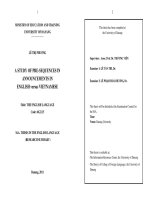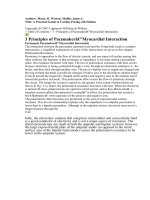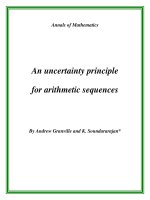Myocardial viability sequences
Bạn đang xem bản rút gọn của tài liệu. Xem và tải ngay bản đầy đủ của tài liệu tại đây (692.37 KB, 10 trang )
Myocardial
Viability
Sequences
TurboFLASH
α
TR
vs
TrueFISP
α
α
Gslice
Gslice
Gread
Gread
Gphase
Gphase
Spoiler Pulse + Unbalanced Gradients:
Insensitive to Field Inhomogeneity Artifacts
Lower SNR
TR
−α
Steady State + Balanced Gradients:
Plagued by Field Inhomogeneity Artifacts
Higher SNR
Myocardial Viability
Pulse Sequences
IR TurboFLASH
IR TrueFISP
25 lines/segment
40 heartbeats
2 averages
61 lines/segment
16 heartbeats
2 averages
Canine heart, 2x dose, 1mm x 1mm x 5mm
Myocardial Viability
Pulse Sequences
segmented
• repeats every
IR
other heartbeat
TI nulls viable myocardium
IR
single-shot
• 10-12 heartbeats
needed per image
• repeats every
other heartbeat
TI nulls viable myocardium
TR positions data in late diastolic gating
• only 1 heartbeat
needed per image
Myocardial Viability
Pulse Sequences
Segmented
IR TurboFLASH
10 second breath-hold
Segmented:
Best resolution
Best contrast
x Good Breathhold required
x Sensitive to arrhythmias
Single-Shot
IR TurboFLASH
Single heartbeat
Single-Shot
IR TrueFISP
Single heartbeat
Single-Shot:
x Acceptable resolution
x Acceptable contrast
No breathhold required
Insensitive to arrhythmias
Myocardial Viability
Pulse Sequences
• Use Segmented for Cooperative Patients
• Use Single-Shot for UnCooperative Patients
??
??
Segmented IR TurboFLASH
Single-Shot IR TrueFISP
• patient had poor breathhold
• gives poor image quality
• patient had poor breathhold
• gives acceptable image quality
Myocardial Viability
Pulse Sequences
• Use Segmented for Cooperative Patients
• Use Single-Shot for UnCooperative Patients
Segmented IR TurboFLASH
Single-Shot IR TrueFISP
• requires good breathhold
• gives high resolution
• no breathhold required
• gives acceptable resolution
Myocardial Viability
Pulse Sequences
• Very quick and robust survey of entire heart
• 10 images in 20 heartbeats
• Multiple different views
SingleShot
IR
TrueFISP
Myocardial Viability
Pulse Sequences
•
•
•
•
•
Acquires a 3D volume in one breathhold
Complete coverage of heart with thin slices in 2 - 3 breathholds
Requires very cooperative patient with normal heart rate
Very sensitive to optimal TI setting
Triggered on every heartbeat, high bandwidth & short echo spacing
Segmented
IR Flash 3D
Myocardial Viability
Which Pulse Sequences Should I Use?
1. IR TurboFLASH has been used for a number of years, and has been
extensively studied in the literature. IR TrueFISP is relatively new, and has
not been extensively studied in the literature.
2. For very cooperative patients with normal heart rates and no arrhythmias, the
3D Segmented IR FLASH sequence works well.
3. For moderately cooperative patients with very few arrhythmias, the 2D
Segmented IR TurboFLASH sequence works well.
4. For uncooperative patients who can not breathhold or have significant
arrhythmias, the 2D Single-Shot IR TrueFISP sequence works well.
5.
If you have difficulty determining the optimal TI, use the TI-Scout sequence
and/or the PSIR AutoViability sequence.









